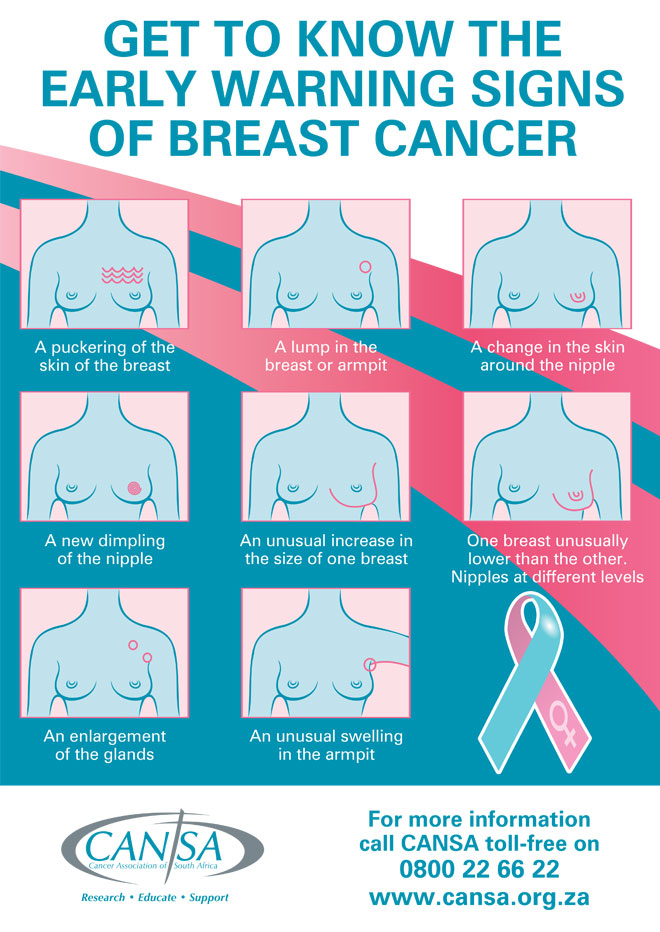Roughly one in every 29 South African women contracts breast cancer within her lifetime – and in some cases it can prove fatal. But checking yourself regularly can go a long way to ensuring that any potential signs and symptoms are caught and dealt with as soon as possible. Although breast cancer is one of the most common cancers affecting women in our generation, it also has a better prognosis than many other strains of the disease, particularly when detected in its early stages.
It’s a good idea to do a breast self-examination (BSE) on a monthly basis – checking your breasts regularly will familiarise you with how they look and feel naturally, making it easier to identify any changes in shape, size, appearance or sensation going forward. Not to mention that frequent checks are more likely to facilitate early awareness of any problems than occasional or intermittent BSEs.
The best time to do a BSE is roughly a week after finishing your period, as this is when your breasts are least likely to be swollen or tender from hormonal influences, making it easier to detect any abnormalities if they exist. Stand in front of a mirror while you do your BSE, so that you can see how your breasts look, as well as how they feel. Start with your hands at your sides, then raise them above your head, then put them on your hips and bend forward. With every position adjustment, look at your breasts from all angles to see if you can detect any changes or anything unusual.
Then lie flat on your back and place a pillow or rolled towel under your left shoulder. Raise your left hand and put it behind your head, using the pads (not the tips) of your right-hand index and middle finger to examine the left breast, working your way around the breast, from the collarbone to the bra line and from the armpit to the breast bone. Use varying levels of pressure on each area of the breast so that you feel the surface tissue as well as the deeper layers of tissue. Repeat this procedure on the right breast.
It is normal for small changes, benign lumps or cysts to occasionally occur in the breasts as they develop – so don’t panic if you do detect something that feels unusual – but certainly pay attention to it and consult your doctor for a second opinion. In addition to checking your own breasts every month, you should visit your doctor annually for a clinical breast examination from the age of 20 onwards, and women over 40 should also have an annual mammogram – an ‘x-ray’ of the breast that allows you to see the internal tissue and identify any lumps or other aberrations – or an ultrasound.
Tell-tale warning signs to watch for
If you notice any of the following you should consult your doctor immediately:
Unusual lumps in the breasts or armpits that feel harder than the surrounding tissue (a little like an Astro, for those of you who remember them…)
Strange rashes, bumps or discolouration on or around the breasts
Dimpling or puckering of the breast skin
Blood or other unusual discharge from the nipples
A change in the size or shape of the breasts
A nipple turned inward towards the breast
Pain in the breasts that is not related to menstruating or pregnancy
Did you know: It’s a myth that breast cancer only affects older women – or even only women for that matter. It can manifest in women as early as their 20s or 30s, and cases of breast cancer can also occur in men, although this is rare.
Other articles you may be interested in:
Regular heath check up’s you’ve got to have
Chemotherapy and your diet
Men and breast cancer
Breast health awareness month
Scarred for life
Take a look at BeautySouthAfrica’s Top 10 articles





13 Responses
So scary how many women get breast cancer these days!
Thank you for this. I am so paranoid. Glad that I don’t have any of the symptoms
Great article. To think that this could in the long run save a life. And made it so easy to understand and follow.
I don’t know if its just me but I tend to get really paranoid when it comes to checking my breasts and often feel things that aren’t really there, so I usually had my mother check and now my husband gets to do the job.
Thank you for the info-graphic. Sometimes having a visual representation to refer to is useful. This is a particularly important topic considering the media coverage recently of celebs who have had mastectomies. Apart from celebs, normal people experience this as well and their stories are not told. Thank you for your aim in informing the general public.
This really is something that all woman should know in order to do regular check ups…thanks
Thank you guys!
Thank you for sharing!
Thank you for sharing this! It is so important for all women to be clued up on breast cancer and how to check for early warning signs.
I thought this was normal, but at the same time, I was kinda doubting all these feeling about my breasts. You have really come up with something that I came across with. It is nice to reach the service for free by a call. Should first ask some questions, then consult a doctor.